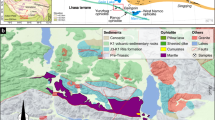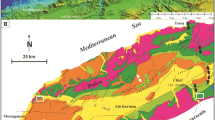Abstract
The early Early Cambrian strata within the bounds of Guizhou Province are almost predominated by black shale deposition. Recently, however, the authors have found a section consisting of a set of mudstones interbedded with limestones at the basement of the Cambrian at Yingping, Fuquan County, Guizhou Province, which provides favorable conditions for the study of marine geochemical characteristics of the early Early Cambrian. The characteristics of intense negative carbon isotopic anomalies near the Precambrian/Cambrian boundary at Yingping, Fuquan County, Guizhou Province, can be correlated with those of global carbon isotopic anomalies at the same time on a global scale, corresponding to the intense negative carbon isotopic anomalies near the Neoproterozoic/Cambrian boundaries at the bottom of the Xiaowaitoushan Member, Huize, Yunnan Province, at the top of the Tsagaan Oloom Formation of Mongolia and at the top of the Salarmy Gol Formation of Siberia, as well as those observed in southwestern United States, Iran, Amman, Poland, Newfoundland, the Great Britain, Canada, etc. Negative carbon isotopic anomalies can be used as the important basis for the division of the Precambrian/Cambrian boundaries. There have been found 8 m-thick black shales and cherts below the intense negative carbon isotopic anomalies in this profile. In the black shales there have been found large amounts of fossils such asBradorida, gernusArchotuba, indicating that during the period of sedimentation of black shales under anaerobic conditions there would be large quantities of organic species living in the sea. But in the section of grayish-green mudstones interbedded with limestones with intense negative carbon isotopic anomalies almost no organic fossil has been found. This may imply that the anaerobic event seems to have little bearing on the mass extinction near the Precambrian/Cambrian boundary, whereas the intense negative carbon isotopic anomaly event appears to be more closely related to the mass extinction occurring near the Precambrian/Cambrian boundary.
Similar content being viewed by others
References
Brasier M. D., Magaritz M., Corfield R., Luo Huilin, Wu Xiche, Ouyang Lin, Jiang Zhiwen, Hamdi B., He Tinggui, and Fraser A. G. (1990) The carbon and oxygen-isotope record of the Precambrian Cambrian boundary interval in China and Iran and their correlation [J].Geology Magazine.127, 319–332.
Brasier M. D. (1992a) Global ocean-atmosphere change across the Precambrian-Cambrian transition [J].Geology Magazine.129, 161–168.
Brasier M. D. (1992b) Nutrient-enriched waters and the early skeletal fossil record [J].Journal of the Geologwal Society, London.149, 621–629.
Brasier M. D. and Shields G. (2000) Neoproterozoic chemostratigraphy and correlation of the Port Askaig glaciation, Dalradian Supergroup of Scotland [J].Journal of the Geological Society, London.157, 909–914.
Chen Nansheng (1990) Lower Cambrian black rock series and associated stratiform deposits in South China [J].Chinese Journal of Geochemistry.9, 244–255.
Corsetti F. A., Awrarnik S. M., Pierce D., and Kaufman A. J. (2000) Using chemostratigraphy to correlate and calibrate unconformities in Neoproterozoic strata from the Southern Great Basin of the United States [J].International Geology Review.42, 516–533.
Corsetti F. A. and Hagadom J. W. (2000) Precambrian-Cambrian transition: Death Valley, United States [J].Geology.28, 299–302.
Gehling J. G., Jensen S., Droser M. L., Myrow P. M., and Narbonne G. M. (2001) Borrowing below the basal Cambrian GSSP, Fortune Head, Newfoundland [J].Geology Magazine.138, 213–218.
Kaufman A. J. and Knoll A. H. (1995) Neoproterozoic variations in the carbon isotopic composition of seawater: stratigraphic and biogeochemical implications [J].Precambrian Research.73, 27–49.
Kaufman A. J., Knoll A. H., Semikhatov M. A., Grotzinger J. P., Jacobsen S. B., and Adams W. (1996) Integrated chronostratigraphy of Proterozoic-Cambrian boundary beds in the western Anabar region, northern Siberia [J].Geology Magazine.133, 505–553.
Kaufman A. J., Knoll A. H., and Narbonne G. M. (1997) Isotopes, ice ages, and terminal Proterozoic earth history [J].National Academy of Science Proceedings.94, 6600–6605.
Knoll A. H. and Walter M. R. (1992) Late Proterozoic stratigraphy and Earth history [J].Nature.356, 673–678.
Knoll A. H. (2000) Learning to tell Neoproterozoic time [J].Precambrian Research.100, 3–20.
Kouchinshy A., Bengtson S., Missarzhevsky V. B., Pelechaty S., Torssander P., and Val’kov A. K. (2001) Carbon isotope stratigraphy and the problem of a Pre-Tommotian Stage in Siberia [J].Geology Magazine.138, 387–396.
Landing E. (1994) Precambrian-Cambrian boundary ratified and a new perspective of Cambrian time [J].Geology.22, 179–182.
Li Chiawei, Chen Junyuan, and Hua Tzuen (1998) Precambrian sponges with cellular structures [J].Science.279, 879–882.
Li Shengrong and Gao Zhenming (1996) Silicalites of hydrothermal origin in the Lower Cambrian black rock series of South China [J].Chinese Journal of Geochemistry.15, 113–120.
Luo Huilin, Jiang Zhiwen, and Tang Liangdong (1994)Stratotype Section for Lower Cambrian Stages in China [M]. pp. 1–183. Yunnan Science and Technology Press, Kunming (in Chinese with English abstract).
Magaritz M., Holser W. T., and Kirschvink J. L. (1986) Carbon-isotope events across the Precambrian/Cambrian boundary on the Siberian platform [J].Nature.320, 258–259.
Magaritz M., Kirschvink J. L., Latham A. J., Zhuravlev A. Y., and Rozanov A. Y. (1991) Precambrian-Cambrian boundary problem; Carbon isotope correlations for Vendian and Tommotian time between Siberia and Morocco [J].Geology.19, 847–850.
Melezhik V. A., Gorokhov I. M., Kuznetsov A. B., and Fallick A. E. (2001) Chemostratigraphy of the Neoproterozoic carbonates; implications for ‘blind dating’ [J].Terra Nova.13, 1–11.
Melezhik V. A., Gorokhov I. M., Fallick A. E., Roberts D., Kuznetsov A. B., Zwaan K. B., and Pokrovsky B. G. (2002) Isotopic shtratigraphy suggests Neoproterozoic ages and Laurentian ancestry for high-grade marbles from the North-Central Norwegian Caledonides [J].Geology Magazine.139, 375–393.
Narbonne G. M. and Aitken J. D. (1995) Neoproterozoic of the Mackenzie Mountains, northern Canada [J].Precambrian Research.73, 101–121.
Shen Y., Zhao R., Chu X., and Lei J. (1998) The carbon and sulfur isotope signatures in the Precambrian-Cambrian transition series of the Yangtze Platform [J].Precambrian Research.89, 77–86.
Shen Y. and Schidlowski M. (2000) New C isotope stratigraphy from southwest China; Implications for the placement of the PrecambrianCambrian boundary on the Yangtze Platform and global correlations [J].Geology.28, 623–626.
Shen Y., Schidlowski M., and Chu Xuelei (2000) Biogeochemical approach to understanding phosphogenic events of the terminal Proterozoic to Cambrian [J].Palaeogeography, Palaeoclimatology, Palaeoecology.158, 99–108.
Strauss H., Vidal G., Moczydlowska M., and Paczesna J. (1997) Carbon isotope geochemistry and palaeontology of Neoterozoic to Early Cambrian siliciclastic successions in the East European Platform, Poland [J].Geology Magazine.134, 1–16.
Walter M. R., Veevers J. J., Calver C. R., Gorjan P., and Hill A. C. (2000) Dating the 840 544 Ma Neoproterozoic interval by isotopes of strontium, carbon, and sulfur in seawater, and some interpretative models [J].Precambrian Research.100, 371–433.
Wang Yangeng, Yin Gongzheng, Zheng Shufeng, Qing Shourong, and Zhu Shuncai (1984)The Upper Precambrian and Sinian-Cambrian boundary in Guizhou [M]. pp. 1–230. Guizhou People’ s Publishing House, Guiyang (in Chinese with English abstract).
Xiao Shuhai, Zhang Yun, and Knoll A. H. (1998) Three-dimensional preservation of algae and animal embryos in a Neoproterozoic phosphorite [J].Nature.291, 553–558.
Yang Ruidong, Zhao Yuanlong, and Guo Qingjun (1999) Algae and acritarchs and their paleoceanographic significance from the early Early Cambrian black shale in Guizhou, China [J].Acta Palaeonotologica Sinica.38 (sup), 145–156 (in Chinese with English abstract).
Yang Ruidong, Chen Meng’e, and Zhao Yuanlong (2002) New discovery of bio-fossils at the bottom of the Cambrian of central Guizhou [J].Progress in Natural Science.12, 226–229 (in Chinese).
Yang Ruidong, Zhang Weihua, Jiang Lijun, and Gao Hui (2003) Members of the Chengjiang Biota from the Lower Cambrian Niutitang Formation, Zunyi County, Guizhou Province, China [J].Acta Geologica Sinica.77, 145–150 (in Chinese with English abstract).
Yu Bingsong and Qiu Yuzhuo (1998) The geochemistry of sedimentary rocks and its relation to crustal evolution in the Southwest Yangtze Massif [J].Chinese Journal of Geochemistry.17, 265–274.
Yuan Xunlai, Xiao Shuhai, Yin Leiming, Knoll A. H., Zhou Chuanming, and Mu Xinan (2002a) Doushantuo fossils: Life on the Eve of Animal Radiation [M]. pp. 1–171. University of Science and Technology of China Press, Hefei (in Chinese).
Yuan Xunlai, Xiao Shuhai, Parsley R. L., Zhou Chuanming, Chen Zhe, and Hu Jie (2002b) Towering sponges in an Early Cambrian Lagerstatte: Disparity between nonbilaterian and bilaterian epifaunal tierers at the Neoproterozoic-Cambrian transition [J].Geology.30, 363–366.
Zhao Yuanlong, Steiner M., Yang Ruidong, and Edmann B-D. (1999) Discovery and significance of the early metazoan biotas from the Lower Cambrian Niutitang Formation Zunyi, Guizhou, China [J].Acta Palaeonotologica Sinica.38 (sup), 132–144 (in Chinese with English abstract).
Author information
Authors and Affiliations
Corresponding author
Additional information
This research work was financially supported jointly by the State Key Basic Research Program (2002CCC02600), the Outstanding Youth Scientists and Technicians Foundation of Guizhou Province, the National Natural Science Foundation of China (Grant No. 400462001, 40062001) and the China Postdoctoral Science Foundation.
Rights and permissions
About this article
Cite this article
Ruidong, Y., Shijie, W., Ziyuan, O. et al. Stratigraphical and biological significance of negative carbon isotopic anomalies in the basal Cambrian series of Guizhou Province. Chin. J. Geochem. 24, 108–115 (2005). https://doi.org/10.1007/BF02841153
Issue Date:
DOI: https://doi.org/10.1007/BF02841153




